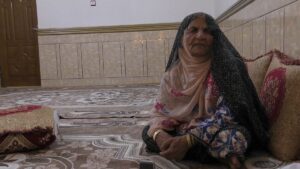Documentation of Kholosi as an endangered language

A Kholosi storyteller is telling a folktale. Photo of Fatemeh by Maryam Nourzaei, 2017. Click on image to access collection.
| Language | Kholosi |
| Depositor | Maryam Nourzaei |
| Affiliation | Uppsala University |
| Location | Iran |
| Collection ID | 0659 |
| Grant ID | |
| Funding Body | |
| Collection Status | Collection online |
| Landing page handle | http://hdl.handle.net/2196/b68d7b6d-5d90-47ff-b93d-55181fa342f9 |
Summary of the collection
The collection is an outcome of an ongoing documentation project of the Kholosi language. The project is a collaborative effort between myself and a group of Kholosi community members, who are involved designing the collection content as well as in collecting and recording data and translating it into Persian. The deposited data consists of various genres, topics, and natural interactions between native speakers. The data has been recorded in video and audio-only formats. The only parts of the corpus that were recorded with audio only are sociolinguistic information, some tales, and certain grammatical elicitations. Information about all the sessions is available in English.
Group represented
The origin of the Kholosi people is still uncertain. Members of the community gave me various answers in this regard, e.g., that they migrated from India, from Sindh in Pakistan, and from Dashtiyari in Sistan and Balochistan province, Iran. Kholosi is spoken mainly in two villages, Kholos and Gotāv. This documentation project has been carried out in these villages. The Kholosi people share a common heritage culture and tradition with their Iranic neighbors. Only their language distinguishes them from other groups in the region. I wish to thank all the Kholosi people in these villages for accepting and hosting me, in particular the families of Mr. Hasan Sabui and Mr. Mohammad Pahang
Collection contents
In the current version of the collection, the corpus consists of approximately two hours of recorded natural language use. It includes:
life stories,
everyday conversation,
folktales,
demonstration of cooking practices.
Acknowledgement and citation
Users of any part of this collection should acknowledge Maryam Nourzaei as the main investigator, and Hava Sabui as a core member of the research team. The main participants who have shared their narrations should also be acknowledged by name. The relevant information is available in the metadata
To refer to any data from the collection, please cite as follows:
Nourzaei, Maryam. 2022. Documentation of Kholosi as an endangered language. Endangered Languages Archive. Handle: http://hdl.handle.net/2196/00-0000-0000-1124-F24G-4. Accessed on [insert date here].


